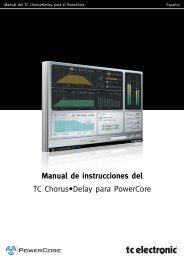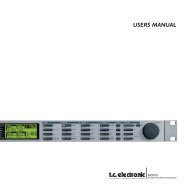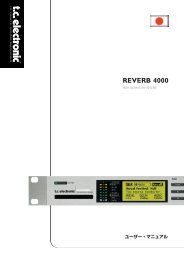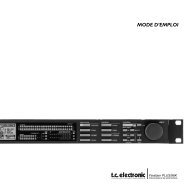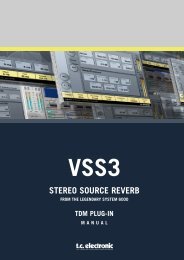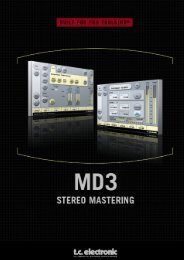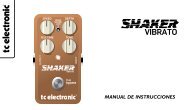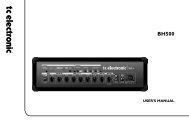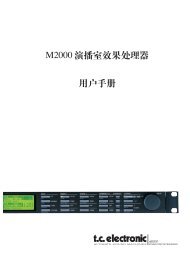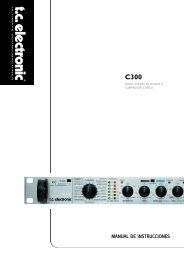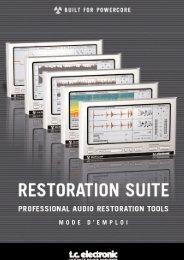EQ Station Manual v. 2.01 sw. 220 English - TC Electronic
EQ Station Manual v. 2.01 sw. 220 English - TC Electronic
EQ Station Manual v. 2.01 sw. 220 English - TC Electronic
You also want an ePaper? Increase the reach of your titles
YUMPU automatically turns print PDFs into web optimized ePapers that Google loves.
Network of 2 or more <strong>EQ</strong> <strong>Station</strong>s<br />
QUICK SETUP REFERENCE<br />
......and setup the following:<br />
• Rename all <strong>EQ</strong> <strong>Station</strong>s with different names such as;<br />
<strong>EQ</strong>S#1, <strong>EQ</strong>S#2 etc. In <strong>EQ</strong> <strong>Station</strong> networks all units<br />
must have unique names.<br />
• Set Cluster. The Cluster defines a group of <strong>EQ</strong> <strong>Station</strong>s.<br />
There can be more Clusters in a network. Per default the<br />
Cluster is set to set to “A” - for this example, - leave all<br />
<strong>EQ</strong> stations at this setting.<br />
• Set Device Number on all <strong>EQ</strong> <strong>Station</strong>s. This number<br />
specifies in which order channels will be assigned to<br />
Cluster locations when you later perform a Cluster Auto<br />
Setup - see example on adjacent page.<br />
When a network of two or more <strong>EQ</strong> <strong>Station</strong>s is build all<br />
channels must be assigned to a location in the Cluster<br />
map found at the Global page.<br />
A convenient “Auto Assign” function makes it very<br />
easy to make a Cluster setup. Specific re-routing of<br />
channels can always be made later.<br />
• Connect power and audio connections according to the<br />
previously described Setups.<br />
• Connect also all <strong>EQ</strong> <strong>Station</strong>s via the RJ45 Link<br />
connections using cross-coupled ethernet cables.<br />
• Power on ALL units.<br />
• On each unit, one by one: Go to the Setup-Network and<br />
Device page....<br />
• Set IP address. All <strong>EQ</strong> stations must have unique I/P<br />
addresses. The default address in the <strong>EQ</strong> <strong>Station</strong> is set<br />
to 192.168.1.100. Leave the first <strong>EQ</strong> <strong>Station</strong> at that<br />
address. Change the next to 192.168.1.101 - and so<br />
forth.<br />
• The Subnet mask is per default set to 255.255.255.0<br />
and should only be changed if you at a later stage<br />
connect your <strong>EQ</strong> stations to a PC network that uses a<br />
different Subnet mask.<br />
- for the example on the adjacent page, - leave all <strong>EQ</strong><br />
<strong>Station</strong>s at 255.255.255.0.<br />
Important!<br />
You MUST ALWAYS reboot your <strong>EQ</strong> <strong>Station</strong>s after you<br />
have changed:<br />
• Name<br />
• Device Numbers<br />
• IP Addresses<br />
• Subnet mask<br />
..... before performing the Auto Setup described in the<br />
following.<br />
6




